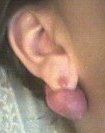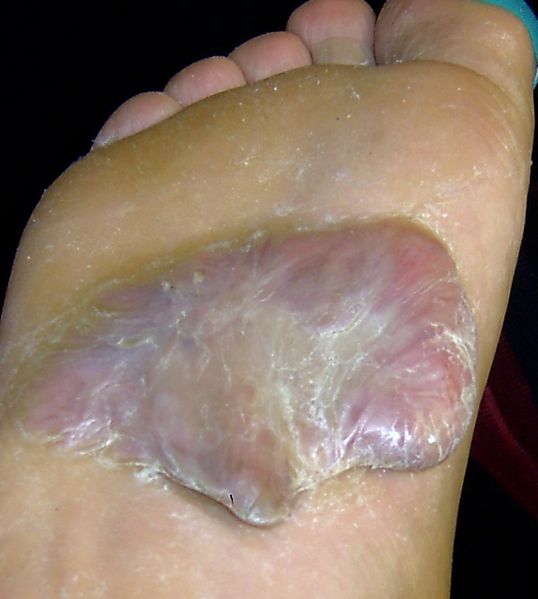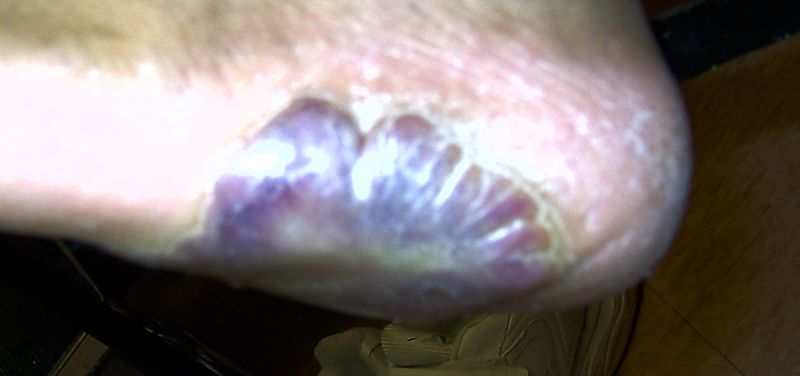Keloid
Template:DiseaseDisorder infobox Editor-In-Chief: C. Michael Gibson, M.S., M.D. [1];Associate Editor(s)-in-Chief: Kiran Singh, M.D. [2]
Overview
A keloid is a type of scar which results in an overgrowth of tissue at the site of a healed skin injury. Keloids are firm, rubbery lesions or shiny, fibrous nodules, and can vary from pink to flesh-colored or red to dark brown in color. A keloid scar is benign, non-contagious, and usually accompanied by severe itchiness, sharp pains, and changes in texture. In severe cases, it can affect movement of skin. Keloids should not be confused with hypertrophic scars, which are raised scars that do not grow beyond the boundaries of the original wound and may reduce over time.
Occurrence

Keloids expand in claw-like growths over normal skin. They have the capability to hurt with a needle-like pain or to itch without warning, although the degree of sensation varies from patient to patient.
If the keloid becomes infected, it may ulcerate. The only treatment is to remove the scar completely. However, the probability that the resulting surgery scar will also become a keloid is high, usually greater than 50%.
Keloids form within scar tissue. Collagen, used in wound repair, tends to overgrow in this area, sometimes producing a lump many times larger than that of the original scar. Although they usually occur at the site of an injury, keloids can also arise spontaneously. They can occur at the site of a piercing and even from something as simple as a pimple or scratch. They can occur as a result of severe acne or chickenpox scarring, infection at a wound site, repeated trauma to an area, excessive skin tension during wound closure or a foreign body in a wound. Keloids can sometimes be sensitive to chlorine.
Keloids affect both sexes equally, although the incidence in young female patients has been reported to be higher than in young males, probably reflecting the greater frequency of earlobe piercing among women. There is a fifteen times higher frequency of occurrence in highly pigmented people. It is speculated that people who possess any degree of African descent, regardless of skin color, may be especially susceptible to keloid occurrences.
History in medicine
Keloids were described by Egyptian surgeons around 1700 BC. Baron Jean-Louis Alibert (1768-1837) identified the keloid as an entity in 1806. He called them cancroide, later changing the name to cheloide to avoid confusion with cancer. The word is derived from the Greek chele, meaning crab's claw, and the suffix -oid, meaning like. For many years Alibert's clinic at the L'Hôpital Saint-Louis was the world’s center for dermatology.
Intentional keloids
The Olmec of Mexico in pre-Columbian times used keloid scarification as a means of decoration. In the modern era, women of the Nubia-Kush in Sudan are intentionally scarified with facial keloids as a means of decoration. The Nuer and Nuba use lip plugs, keloid tattoos along the forehead, keloid tattoos along the chin and above the lip, and cornrows. As a part of a ritual the people of Papua New Guinea cut their skin and insert clay or ash into the wounds so as to develop permanent bumps (known as keloids or weals). This painful ritual honors members of their tribe who are celebrated for their courage and endurance.
Locations of keloids
Keloids are mostly found on earlobes, the sternum, shoulders, the upper back and any place where abrasion has occurred. These are usually the result of pimples, insect bites, scratching, burns, or other skin trauma. Certain procedures are known to cause keloid formation such as within post-operative surgical scars or on earlobes following piercing and behind the ears after otoplasty.
Incidence
People of all ages can develop a keloid. Children under 11 are less likely to develop keloids, even when they get their ears pierced. Keloids may also develop from pseudofoliculitis barbae, continued shaving when one has razor bumps will cause irritation to the bumps, infection and over time keloids will form. It would thus be wise for a man with razor bumps to stop shaving for a while and have the skin repair itself first before undertaking any form of hair removal.
Diagnosis
Physical Examination
Ear
Trunk
Head
Treatments
No treatment for keloids is considered to be 100% effective. Some of the treatments that are currently available are described below. These treatments have varying degrees of effectiveness. All the invasive methods of treatment like surgery carry a serious risk of the keloid recurring and becoming bigger than it previously was.
- Surgery — Surgery requires great care during and after the operation. Keloids that return after being excised may be larger than the original. There is a 50% chance of recurrence after surgical removal. However, keloids are less likely to return if surgical removal is combined with other treatments. Surgical or laser excision may be followed by intralesional injections of a corticosteroid. Plastic closure of the skin including techniques such as v-plasty or w-plasty to reduce skin tension are known to reduce recurrence of keloids following excision.
- Dressings — Moistened wound coverings made of silicone gel (such as Dermatix) or silastic have been shown in studies to reduce keloid prominence over time. This treatment is safe and painless, although some patients may experience increased itchiness from wearing the dressing for an extended period of time.
- Steroid injections — Steroid injections are best used as the scar begins to thicken or if the person is a known keloid former. A series of injections with triamcinolone acetonide or another corticosteroid may reduce keloid size and irritation. However, injections are often uncomfortable and in large and/or hard scars can be difficult to perform, requiring local anesthetic for people over 16, and full anesthetic for people under. The treatment area can become very painful as the anesthetic wears off.
- Compression — Compression bandages applied to the site over several months, sometimes for as long as six to twelve months, may lead to a reduction in the size of the keloid. This is the best treatment for preventing new scars.
- Cryosurgery — Cryosurgery is an excellent treatment for keloids which are small and occur on lightly pigmented skin. It is often combined with monthly cortisone injections. The use of cryotherapy is limited since it causes skin blanching. It freezes the skin and causes sludging of the circulation beneath, effectively creating an area of localized frostbite. There is a slough of skin and keloid with re-epithelization.
- Radiation therapy — Electron beam radiation can be used at levels which do not penetrate the body deeply enough to affect internal organs. Orthovoltage radiation is more penetrating and slightly more effective. Radiation treatments reduce scar formation if they are used soon after a surgery while the surgical wound is healing. This is one of the most effective procedures.[2]
- Laser therapy — This is an alternative to conventional surgery for keloid removal. Lasers produce a superficial peel but often do not reduce the bulk of the keloid. The use of dye-tuned lasers has not shown better results than that of cold lasers.
- Newer treatments — Drugs that are used to treat autoimmune diseases or cancer have shown promise. These include alpha-interferon, 5-fluorouracil and bleomycin. However, there is a need for further study and evaluation of this treatment technique.
Case presentation
This is a young male with bilateral keloid formation on the plantar surfaces of both feet. He has never been treated for this condition. There are other much smaller keloids located at small inlets on the glabrous(hairless) skin.
 |
 |
 |
Ear
References
- ↑ 1.00 1.01 1.02 1.03 1.04 1.05 1.06 1.07 1.08 1.09 1.10 1.11 1.12 1.13 1.14 1.15 1.16 1.17 1.18 1.19 1.20 1.21 "Dermatology Atlas".
- ↑ Ogawa R, Mitsuhashi K, Hyakusoku H, Miyashita T. (2003). "Postoperative electron-beam irradiation therapy for keloids and hypertrophic scars: retrospective study of 147 cases followed for more than 18 months". Plast Reconstr Surg. 111 (2): 547-53 & 554-5. PMID 12560675.
External links
- Keloids and hypertrophic scars: a review
- Keloids and hypertrophic scars, german version (Rossmann N, 2004)
- Medical Encyclopedia: Keloids
- Home remedies for Keloids Treating the infection underneath
- Radiation Therapy for Keloid
de:Keloid
it:Cheloide
he:קלואיד
nl:Keloïd
fi:Keloidi
sv:Keloid
![Keloid. Adapted from Dermatology Atlas.[1]](/images/9/91/Keloid07.jpg)
![Keloid. Adapted from Dermatology Atlas.[1]](/images/0/0e/Keloid09.jpg)
![Keloid. Adapted from Dermatology Atlas.[1]](/images/2/21/Keloid10.jpg)
![Keloid. Adapted from Dermatology Atlas.[1]](/images/6/65/Keloid18.jpg)
![Keloid. Adapted from Dermatology Atlas.[1]](/images/2/22/Keloid19.jpg)
![Keloid. Adapted from Dermatology Atlas.[1]](/images/b/bd/Keloid21.jpg)
![Keloid. Adapted from Dermatology Atlas.[1]](/images/c/c5/Keloid22.jpg)
![Keloid. Adapted from Dermatology Atlas.[1]](/images/f/f7/Keloid23.jpg)
![Keloid. Adapted from Dermatology Atlas.[1]](/images/f/f0/Keloid12.jpg)
![Keloid. Adapted from Dermatology Atlas.[1]](/images/1/1d/Keloid13.jpg)
![Keloid. Adapted from Dermatology Atlas.[1]](/images/2/28/Keloid14.jpg)
![Keloid. Adapted from Dermatology Atlas.[1]](/images/d/dd/Keloid15.jpg)
![Keloid. Adapted from Dermatology Atlas.[1]](/images/7/72/Keloid16.jpg)
![Keloid. Adapted from Dermatology Atlas.[1]](/images/f/f8/Keloid17.jpg)
![Keloid. Adapted from Dermatology Atlas.[1]](/images/f/f4/Keloid06.jpg)
![Keloid. Adapted from Dermatology Atlas.[1]](/images/4/4a/Keloid01.jpg)
![Keloid. Adapted from Dermatology Atlas.[1]](/images/7/7c/Keloid02.jpg)
![Keloid. Adapted from Dermatology Atlas.[1]](/images/2/21/Keloid03.jpg)
![Keloid. Adapted from Dermatology Atlas.[1]](/images/c/c8/Keloid04.jpg)
![Keloid. Adapted from Dermatology Atlas.[1]](/images/9/91/Keloid05.jpg)
![Keloid. Adapted from Dermatology Atlas.[1]](/images/4/48/Keloid20.jpg)
![Keloid. Adapted from Dermatology Atlas.[1]](/images/5/5b/Keloid08.jpg)